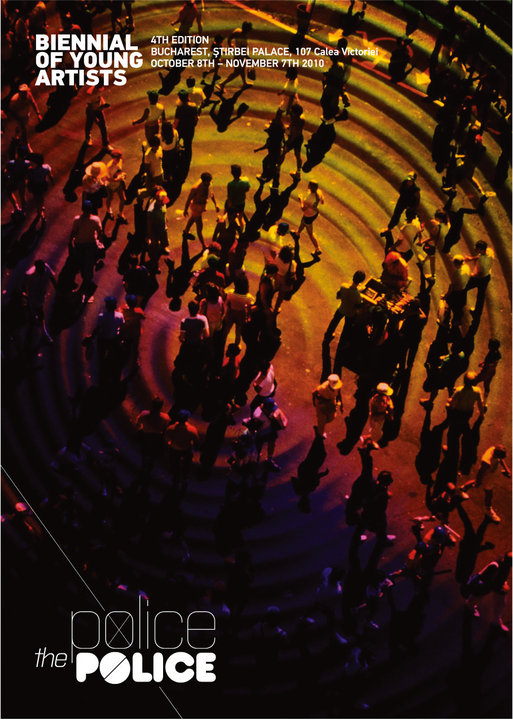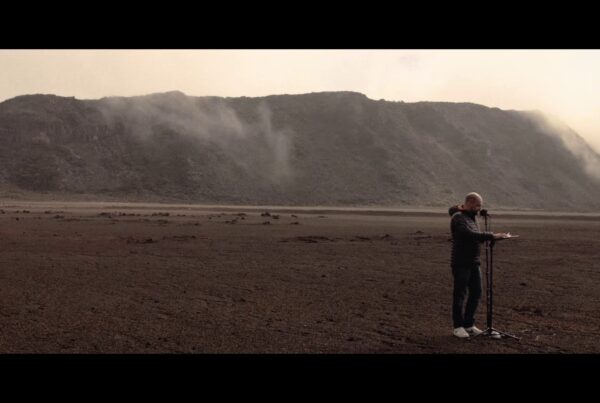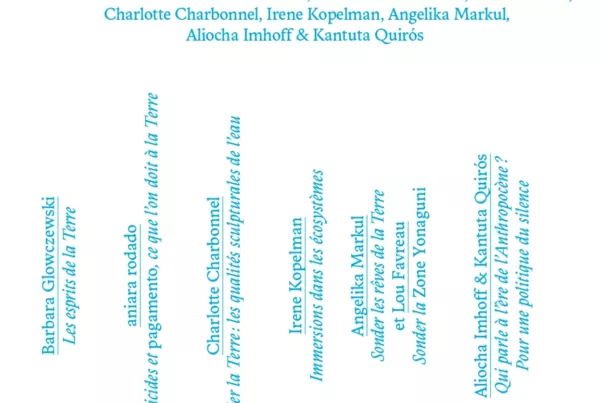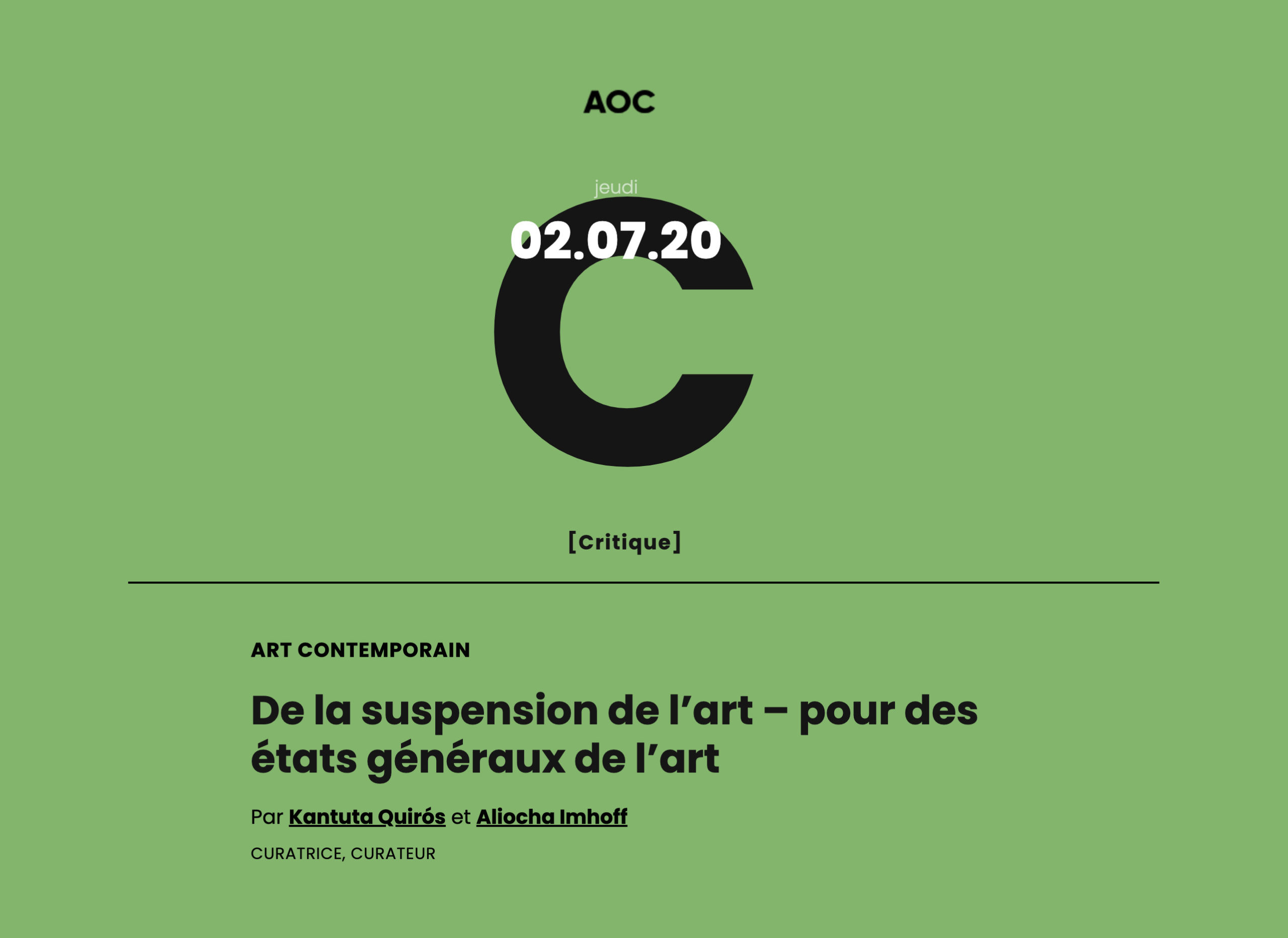For an archeology of the gaze
Le peuple qui manque (Kantuta Quiros & Aliocha Imhoff)
Art Critics & curators
Article publié en 2010 dans le catalogue d’exposition de la Biennale Young artists Biennial, « Police the Police », Bucarest, Roumanie.
Curator : Mica Gherghescu
8 octobre 2010 au 7 novembre 2010
Fondation culturelle Meta
If seeing is a power, nowadays it certainly manifests itself in its most extended form: we witness the transformation of the contemporary gaze into surveillance. Being at the core of present-day surveillance mechanisms is a phenomenon that can be understood through the increasing use of scanning technologies, as means of production for tracing systems and visual continuity. The network within which everybody is watching and is possibly being watched outdates Michel Foucault’s device of the Panopticon observation. Numerous artists have used critical analysis to dissect this ubiquitous transformation of modern gaze into surveillance: from Michael Klier’s Der Reise (1983) to Harun Farocki’s L’oeil-Machine (2003), passing through Renaud Auguste- Dormeuil’s or Alain Declercq’s videos.
These analytical operations belong to a broader history of the gaze and its counter-devices. The film makers and video directors have long taken interest in the deconstruction of the mechanisms connecting the act of watching to the question of power, and leading to a regime of generalized surveillance.
Recalling the counter-devices invented by these artists, film makers and video directors (whose most contemporary version would in this case be sousveillance), we aim to see what are the work techniques we could use today for future resistance. In a brief attempt to reiterate these radical gestures, we will see how the invention of counter-watching has developed, confronted with the colonial, patriarchal, mechanical or panoptical watching. This was possible in the first place only due to those inversions in the sequence of watching, that reveal the mechanisms of reification, guardianship, and control. In order to build genuinely democratic information practices, contemporary mediactivism has tried to advance new “polyphonic” networks of images. The rhizomatic strategies involved still had to deal with the hegemonic control of image production and dissemination in the mass and official media. Finally, one will infer from the historical practices of experimental cinema, which even more propose a pure and simple dissolution of seeing into touching and feeling, that the invention of a third eye and of tactile watching is the final effort of abolishing the imprint of power over watching.
“Knowing the forces at play” (Alain Declercq)
French artist Alain Declercq’s work belongs to a history of techniques used in reversing the emission points of the look. For him, escaping surveillance has developed into surveilling the surveillance, enacted by vigilance produced from its own moving, performing, photographing, and filming body. Declercq has been working for over a decade on control societies, using logic to the extent of unveiling its limits, surveilling the systems of surveillance themselves. One can detect in his obstinate inquiries some fragile game between exposing the technologies of power, truth regimes and fictional evidence, suspicion, paranoia and unexpected reversals of reality.
In Hidden (2008) he diverts security regulations by placing a pinhole camera obscura in front of the constructions and buildings protected by the city legislation post Ground Zero, thus constituting an inventory of forbidden places of representation. Using mise en abîme and the demystification of points of view, the scopic lens cut is impressed within the frame, roundly shaped by an absolute eye. Surveillance is therefore replicated in the frame itself, revealing “not the invisible but a visible whose visual character was forbidden”, in Gérard Wajcman’s 1 words.
In Embedded, which was filmed during the students’ manifestations organized in Paris in 2006, among the forces of order, and mainly among civilian police officers, he infiltrates amongst the infiltrated, only to be exposed later on. For Mike, an undecidable piece of docufiction on the iconography of international plots, Alain Declercq makes up a character, Mike, who is in charge of surveying the actions of international networks. In a troubling ballet of fiction and reality, on June 24th 2005, a criminal brigade and some French anti-terrorists enter his studio in Bordeaux, accusing him of “working with the enemy”. Alain Declerq would be interrogated, his studio searched, and all of his documents and art works carefully analyzed. He would then realize he had been himself observed for the last several months. As Alain Declerq would say later, while reproducing on stage the rooms of this perquisition, “knowing the forces at play” equals terrorism for any forces of order. His work of fictionalized reality allows him to unmask the way security and surveillance dynamics feed themselves from staging reality and the way fictionalizing actually permits them to exist. While Alain Declercq’s work can be seen as typical for the so-called “reversed surveillance” strategies, artists and film makers have invented throughout history different visual devices and perceptive protocols, to free themselves of the neutralization and reification of watching.
Watching the Watch
Some of these subversive strategies bring out a mise en abîme of the devices of watching, denaturalizing the ideologies that feed the sequence of look. Some of the references are Valie Export and Godard/Gorin and the Dziga Vertov group, with the amazing Letter for Jane (1972), Coco Fusco and Guillermo Gómez-Peña, or even recently Renzo Martens, with Enjoy Poverty, Episode 3 (2008),
etc. These strategies have been particularly used in video or cinema by minority groups, within a framework of self-statement and self-production. These practices defuse objectivating watches and expertise, leading to a self representation of the recorded subjects, and especially of the subjects that are designed as pervert. Also called abnormal – racially, nationally, bodily or just different –, they are what Donna Harraway calls “marked bodies” 2 .
Within the framework of identity policies – most of all the feminist, queer and postcolonial – it was necessary to produce cinema that no longer focused on women, homosexuals, racial minorities, subordinate subjects, etc. Instead, we came up with cinema that came straight from under a condition of minority, as if to disrupt the device producing the truth on bodies and identities. In other words, those who had created the very objects of medical, psychiatric, anthropological and colonial expertise have progressively claimed the establishment of a local knowledge and a set of self representations that question the hegemonic dogma. A rupture Michel Foucault calls “the insurrection of subjugated knowledge”.
A well-known example of feminist art is the case of the Austrian artist Valie Export, with her Touch Cinema (1968), a street performance that she realized in 1968 which is considered to be “the first true feminist film”. Valie Export would wander the streets carrying a “cinema theatre” (a rectangular box in which the passers-by could plunge their hand for five minutes and touch her breasts), attached to her naked chest, thus reversing the patriarchal power balances that govern women’s representations, and the voyeuristic staging of the woman’s body in cinema. Maybe Touch Cinema becomes even more a form of cinema – cinema that is forced to step out of itself in order to question its own mechanism, cinema that explodes, in order to define itself as a mechanism of watching.
In The Couple in the Cage, artists Guillermo Gómez-Peña and Coco Fusco operate a true act of “reversed ethnography”. During a several month tour, they would show themselves in an itinerant cage, pretending to be an Amerindian couple from an imaginary island, “far from civilization”, and thus testing the spectator. The opening of this performance, Two Undiscovered Amerindians visit took place in the Cristopher Col
umbus Square in Madrid, in 1992, during the celebration of the “discovery” of the Americas. It was shown in art places or natural history museums. In his book English is Broken Here, Coco Fusco describes how “the cage became the white screen on which the public projected their fantasies and the illusion of what they were. Since we were assuming the stereotypical role of the domesticated savage, a great part of the public felt authorized to adopt the role of the colonizer (…) 3” . Diana Taylor will underline that this piece reflects the failure of each spectator, since no reaction could possibly be adequate to this situation 4. Heir of the Chicano Art Movement, Guillermo Gómez-Peña, performer, video director and renowned writer, founding member of Border Art Workshop, and of the la Pocha Nostra performers’ collective, will carry on this reversed anthropology work. On the occasion of his later performances/shows, this deconstruction will be allowed by a staging of paintings and interactive musées vivants co-created with the public, and of a “Musée Vivant des Identités Fétichisées”, made up of ethnographical dioramas or of freak shows. By exhibiting and exacerbating the fetish of subaltern identities, they mock contemporary post-colonial techniquesof representation.
The diorama is a representation technique of the indigenous peoples, commonly used in ethnography museums. Invented at the beginning of the 19th century by Daguerre, the diorama is composed of large panels illuminated from behind and, since then, it has been used for ethnographic reconstructions, capturing the subjects in their traditional environment: along with their costumes, tools, weapons and sometimes with their entire housings. Gómez-Peña uses these contextual settings both photographically or performatively, his characters resorting to a wide range of objects and identity markers. His dioramas of “artificial savages” update the voyeuristic relation between the self – proclaimed as center – and its confines, within the frame of cultural tourism, global art, total TV, pop culture. All along, a new epistemological relation between subject and object emerges, a relation between mainstream and subcultures, liberated from questions of power and privileges 5.
Mediactivism and polyphonic settings: inventing the “democracies” of watching
Since the ’90s, these actions of reversal have been driven even further by media criticism and by collective informational mobilizations, notably practiced among alter-globalist activists.
According to Jello Biaffra’s famous motto, “Don’t hate the media, become the media”, the renewal of the “critical media” in the ’90s relied on rejecting the restraining of the information producers’ group and on the asymmetry between the traditional media and their spectators6. Mediactivists have thus put themselves at the service of a subjective informational practice, rejecting professional expertise and redistributing the right to speak to everybody, by installing devices for the production of image and open speech. They have equally worked to propagate the emission centers, at the same time trying to put together platforms of collective action, dismissing the rupture between information and action. Two audiovisual productions are representative for this strategy. The first, This is What Democracy Looks Like (2000) is the work of the Big Noise collective and of the IMC (Independent Media Center), that have dedicated themselves to the construction of reticular networks of information since the late ’90s. During the manifestations against the OMC in Seattle 1999 the IMC shot a report in the streets, using more cameras that any other media, coordinating more than a hundred mediactivists and gathering more than 300 hours of rushes.
This is What Democracy Looks Like captures the plurality of the images shot by these mediactivists, mostly involved in independent media for several years. It could stand as a model for imagining the experience of alternative media and their cooperative and highly subjective practices of collective and autonomous creation. Here lies the multiplicity of gazes and watchers that allow them to produce their own story of the event and to see themselves as observing the apparatus of democracy. Stepping back from the reductionist monopoly on image production, no trace of any ideology for informational transparency or “police of truth” is to be found here. It is rather the constitutive power of the multiple fights and a “placed” practice of watching that are to be seen, with no objective dimension.
The second, Burma VJ (2009), edited by Anders Østergaard and produced on the occasion of the repressions in the democratic movements in Myanmar 2007, seizes numerous edits operated on the images taken by Burma video journalists with video cameras or cell phones, at the risk of losing their lives. This striking film marks on the edge of sight, observing everything through sensitive and passionate eyes, spread all around the Burma capital, it maps the repressive actions of a frozen surveillance regime – the Burma military dictatorship.
Cinema as a genre-producing technology
We do not intend to compel a history of watching, but rather to recall the way the subjects of representation could reverse or subvert its intrusive and reifying methods. In 1975, Laura Mulvey published “Visual pleasure and Narrative Cinema” in Screen magazine – a text which rapidly became a reference. The argument strongly relies on the contribution of psychoanalysis in order to deconstruct the Hollywood apparatus as a double device of patriarchal power. On one hand, this device submits women through the script-like construction of the characters, whose points of view are necessarily masculine (narcissist pleasure of identification). On the other hand, through an objective staging, watching turns women into an object of visual pleasure (scopophile pleasure). According to Mulvey, in order to experience visual pleasure in cinema, women can only submit to the narcissist scopophilia of masculine stagings that take over them as objects of pleasure, subjected to the controlling watch. The second wave of feminist theory has developed the idea that the camera itself is the ultimate result of the phallocratic ideology, intensely supported by the industrial development. Teresa de Lauretis will later on talk about the cinema apparatus as a social technology of genre-production 7. Mulvey will call out to the construction of an alternative spectator, and will propose avant-garde cinema as a reaction to the Hollywood “patriarchal cinema”.
Haptic cinema
In order to try to defuse the scopic dimension of the watching and the perspectivist and phallocratic construction of watching through the camera, one could indeed resort to the historical resources of the haptic vision and tactile cinema, mainly explored by the experimental cinema. Resulting from debates on the de-hierarchization of senses, the notion of haptic vision 8 has emerged at the beginning of the 20th century, in the attempt to separate from the optic vision. This would favor a “tactile” vision of the world, issued form the internal body and from the global sensorial richness of the subject. In his text The Logic of Sensation, Gilles Deleuze was saying that, considering the separation from the eye and the hand in Francis Bacon’s thinking, this haptic vision will occur “every time that strict subordination in one direction or the other, relaxed subordination or virtual connection between the eye and the hand will cease to exist, and when the vision itself discovers within itself a function of the touch that is proper to it, that solely belongs to it and differs from its optical function” 9.
The third eye
Thus, if the cinema of Stan Brakhage, a great figure of the underground American cinema, and his filmic gestures in which it is the entire body that sees, are well-known, André Almuro’s are less familiar. Film-maker and composer, together with Jean-Luc Guionnet, he invented a haptic cinema where the camera was no longer guided by the eye, but only by the arm of those who acted and who were being filmed at the same time. At the core of the passionate ceremonies whose cosmic dimension would manifest through homoerotic rituals, Almuro’s films were a unique experience of organic vision, penetrating the bodies and the adjustments of his desire. In the light of the mineral bodily surfaces, in the sculptural shiver of the encounter, André Almuro resorted to a “third eye” that explored tactility, not a blind eye, but one emancipated from visual subordination to the universe of the touch. André Almuro said the starting point for a painter should be the most subjective body: camera at fist (literally), “affective landscapes”, revealing intensities and energies of corporal interventions. His haptic cinema illustrated a kinesthetic way of knowing the world, and film became a proof of transformation for the one performing it. This “kinetic organicity” would then design landscapes created by the “pineal” eye 10. Bill Viola’s The passing (1991) – a parable of the multiple crossings between life and death –, would emerge as the closest investigation possible of the nocturnal breathing and of the ultra subjective vision: he installed a camera on his head and video recorded his sleep. The endless contingencies in between microcosms and macrocosms, sometimes dissolving the vision in the materiality of the video granularity, sometimes in an oceanic vision, would absorb perspectivist structure of the gaze until the latter disappears. These scalar variations allowed the switch of the optical plan to the haptic.
The blind spot
Directly connected to the Californian feminist movement of the ‘60s-’70s, Carolee Schneemann and Barbara Hammer created their first films following the critical heritage of Stan Brakhage. They were working to prod
uce cinema that associates sight and feeling, that brings vision closer to sensation, liberating itself from the masculine gaze. Carolee Schneemann produced Fuses (1967) in the middle of a sexual spree with her companion, James Teeney. The device in Fuses dissolves the distribution of roles both in front of and behind the camera (and, as well, declines the woman as an object of watching), merging the shots from Schneemann’s point of view with Teeney’s: no point of view could then actually be assigned. The film is then used in a very concrete form, through different media: grattage, painting, “physical aggression” of the film (seen as the second skin). Californian producer Barbara Hammer’s project succeeded in escaping the famous “male gaze”, creating “originless images”. Dyketactics (1971) explores new sensual, emotional, and mental areas, inventing an organless, deterritorialized body. Her deconstruction of the masculine representations of carnal experience in cinema undergoes an entire phenomenology of experience.
Finally, having settled in the Cévennes along with the autists, French writer Fernand Deligny (1913-1996) supported the effort to create cinema that is equivalent to wordless language: “refractory to symbolical domestication” and as close as possible to the autistic world. He invented the verb “to camer” 11 as a replacement for “filming”, a manifest term, indicating the importance of an archeology of the technologies of representation. “Camering” is a means of withdrawing from the screenplay and from history as a stance on colonialism, “camering” is like “leering” or “squinting”, the way the autistic children see. “Camering”, that is, to represent the images produced from the condition of a minority which explores the “possibilities of watching”, and to break with an objective dimension in order to produce other potential spectators.
“What a nice verb, to squint. It would be like two oculars, not used for perceiving the outlines; two oculars, like two memories, even if he who films would have something like an eye that lingers on, looking for anything human outside the script-like scene. One should invent the cross-eyed camera” 12, wrote Fernand Deligny.
1. Gérard Wajcman, Portrait de l’artiste en Persée, in Alain Declercq, éditions Blackjack, Loevenbruck, 2010
2. Donna Harraway, chapter Situated Knowledges: The Science Question in Feminism and the Privilege of Partial Perspective in Simians, Cyborgs and Women: The Reinvention of Nature (New York; Routledge, 1991)
3. Author’s tranlastion. In Fusco, Coco. English is Broken Here. New York: The New Press, 1995, p 47 [“The cage became a blank screen onto which audiences projected their fantasies of who and what we are. As we assumed the stereotypical role of the domesticated savage, many audience members felt
entitled to assume the role of colonizer, only to find themselves uncomfortable with the implications of the game”]
4. Diana Taylor, «A Savage Performance: Guillermo Gomez-Peña and Coco Fusco’s “Couple in the Cage”», TDR (1988-), Vol. 42, No. 2 (Summer, 1998), pp. 160-175
5. More on this subject in Guillermo Gómez-Peña, Ethno-Techno, Writings on Performance, Activism And Pedagogy, New York, Routledge, 2005
6. On this, Dominique Cardon and Fabien Granjon, “Les mobilisations informationnelles dans le mouvement altermondialiste”, communication au colloque “Les mobilisations altermondialistes”, Paris, Association française de science politique, 3-5 December 2003.
7. Teresa De Lauretis, Technologies of Gender, Essays on Theory, Film, and Fiction, Bloomington, Indiana University Press, 1987.
8. “(…) haptique, from the Greek verb aptô (toucher), does not design an external relation between the eye and the touch, but a “possibility of seeing”, a type of vision that is different from the optical”, tells us Herman Parret in Spatialiser haptiquement : de Deleuze à Riegl, et de Riegl à Herder. Nouveaux Actes Sémiotiques
9. Gilles Deleuze, Francis Bacon. La logique de la sensation, seconde édition, Paris, Editions du Seuil, 1972.
10. In 2002, André Almuro publishes “L’oeil Pinéal, Pour une cinégraphie” at Paris-Expérimental. The third eye (also called “interior eye” or “soul eye”) is a mystical and esoteric metaphor that indicates, beyond physical eyes, a third instance of watching, that of self awareness. In some traditions, the third eye is symbolically placed on the forehead, between the eyebrows. Certain authors have thus suggested that this third eye designates in fact the pineal gland, located between the two brain hemispheres. (Wikipedia definition)
11. “Camering would consist in respecting that which doesn’t want to say anything, doesn’t say anything, doesn’t address itself, in other words, abdicates from symbolic domestication (…)” Fernand Deligny, “Camérer”, Caméra/Stylo, n°4, September 1983
12. Ibid.



